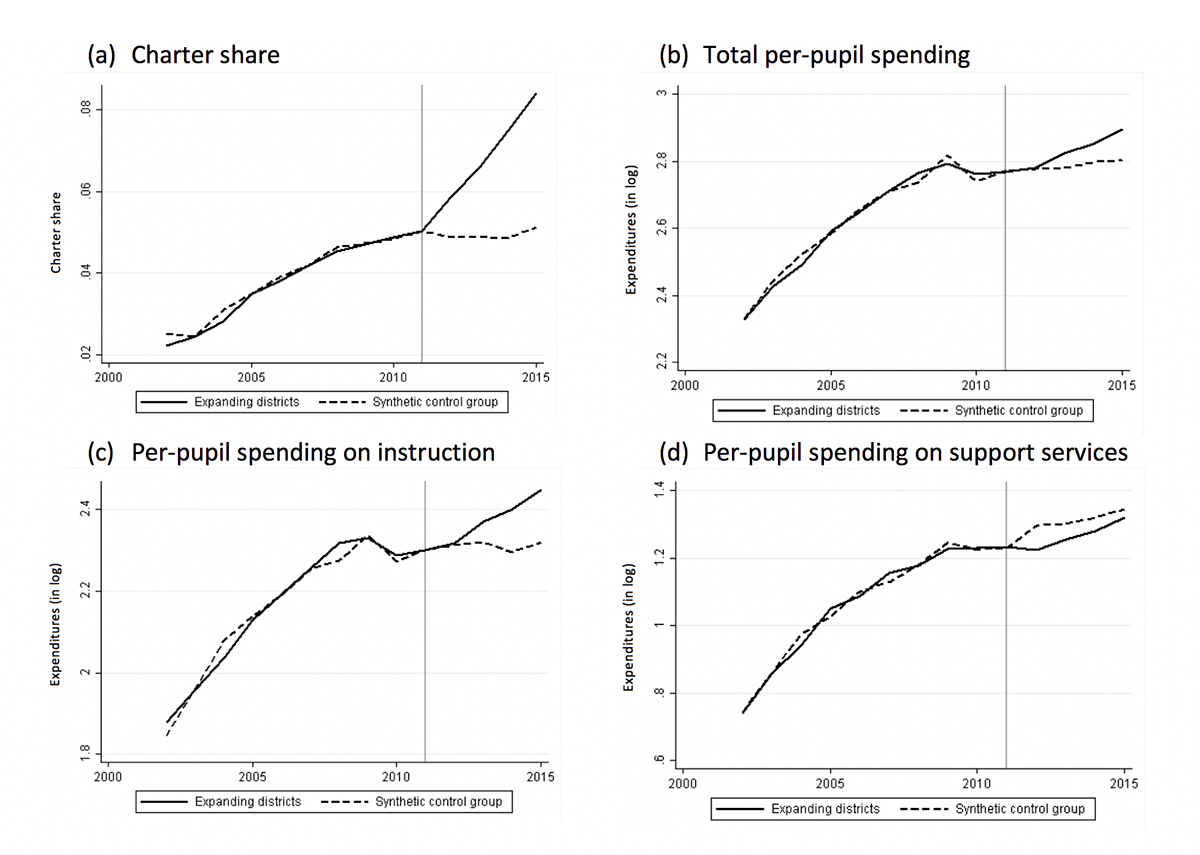
In November 2016, a Massachusetts ballot question on whether or not to expand the charter school sector drew national attention. Over $33 million in campaign spending poured into the commonwealth in what emerged as one of the most expensive ballot questions in the country. A majority voted against an increase in the cap, effectively cutting off further charter growth in many of the state’s urban centers. A new study by two of us (Camille Terrier and Matthew Ridley) digs into one of the main concerns voiced by critics of the proposal to lift the charter cap: how charter growth affects school district finances and their students’ achievement.
Charter schools were originally conceived as a means to spur innovation in traditional public schools, the idea being that competition from the charter sector might lead districts to reallocate spending in ways that enhance student achievement. But the charter sector’s rapid growth has raised concerns about the fiscal pressure imposed on district schools. When a student switches to a charter school, public funding typically follows the student, so charter schools are often criticized for draining resources from district schools. Several recent studies have indeed found that charter expansion can have negative fiscal spillover effects on traditional public schools. [1]
In an effort to avoid a large, sudden reduction in funding for district schools, several states, including Massachusetts, have adopted reimbursement schemes under which a district is reimbursed (wholly, or in part, for a set number of years) for the funding that follows charter students out of the district. [2] In such contexts, the net fiscal impact of charter expansion is unclear.
To quantify charter expansion’s effects on school district finances and student achievement under reimbursement schemes, we studied a reform that led to a large expansion of the charter sector in Massachusetts. Our results reveal that higher charter attendance increased per-pupil expenditures in district schools and shifted school district expenditures towards instruction and away from support services (which encompasses things like student counseling and teacher training) and school administration. We also find that the large charter expansion generated modest positive effects on achievement among students who remain in district schools.
The main challenge to studying charter expansion’s effects on district schools is that charter schools do not decide where to locate or expand at random. If charter schools locate or expand mainly in districts that are increasingly fiscally stressed, for example, expanding districts will show worse fiscal stress—but in this case, fiscal stress is a cause, not an effect, of charter expansion. This makes it difficult to distinguish the effects of charter expansion on district schools from other factors or trends.
To address this challenge, we exploit a policy change in Massachusetts that led to a sizeable charter sector expansion. In 2011, the state raised the limit on the funding districts could allocate to charter schools from 9 percent to 18 percent in districts where student achievement is in the bottom ten percent statewide. Over the next four years, the share of students attending a charter school jumped from 7 percent to 12 percent in districts that expanded their charter sectors. We use a data-driven methodology to identify “control” districts, that is, a group of districts that did not expand their charter sectors after the 2011 reform but had the same evolving charter share and fiscal patterns before the reform. [3] These control districts are as similar as possible to the “expanding” districts in terms of characteristics and trends before the expansion; the main difference is that they did not expand after the reform. Their post-reform fiscal and academic outcomes can thus be used to capture what would have happened to the expanding districts had their charter sector not expanded. This approach constitutes a methodological improvement over previous studies that assess fiscal spillovers in small samples of districts, making their results potentially sensitive to districts’ specificities.
The visual depiction of this exercise is quite telling (see Figure 1): when the share of students in the district attending a charter school jumps, total per-pupil spending in district schools follows suit. After the reform (denoted by the vertical line), total per-pupil expenditures increased by 4.8 percent more in expanding districts than in the synthetic control group of nonexpanding districts. This short-term effect is consistent with, and likely a consequence of, temporary reimbursement aid for expanding districts. Beyond this overall effect on per-pupil spending, we show that traditional public schools (TPSs) in expanding districts also reallocate their expenditures: Per-pupil spending on instruction increased by 5.2% more in expanding districts than in nonexpanding districts, while per-pupil spending on support services dropped by 4.4% more in expanding districts.
Figure 1: Charter Share and District Per-Pupil Expenditures in Charter-Expanding Districts and Non-Expanding Synthetic Control Districts
The fact that schools facing charter competition shift resources from support services to instruction suggests they perceive spending on instruction as more valued by potential students and their families than spending on support services. However, there is evidence that cutting spending on student support can hurt student attainment, raising questions about how the charter expansion affected student achievement. [4]
We find that charter sector expansion has small positive impacts on student achievement, although the effects are not always statistically significant. An increase of 5 percentage points (from 10 percent to 15 percent) in charter school attendance increases non-charter student test scores by 0.03 standard deviations in math and 0.02 in ELA, a modest improvement. These results are in line with previous studies that show charter expansion has a limited impact on student achievement in traditional public schools. [5]
Because the Massachusetts reimbursement funding scheme is only temporary, a natural question is what happens after the end of the refund period? We used charter school openings prior to 2011 to investigate charter expansion’s long-term, post-reimbursement consequences. In the longer run, and particularly after the reimbursement period ends (i.e. when per-pupil revenue returns to its pre-expansion level), we find that charter expansion’s positive effects on both expenditures and achievement tend to disappear (though without becoming negative). Our results also suggest that the positive effects on achievement are largest five to six years after charters expand. These findings are consistent with research suggesting it takes several years for increased spending to impact achievement. [6] The reimbursement scheme appears to insulate districts from the short-term financial shock of charter sector expansion, allowing them to adjust over time and avoid any negative effects.
Concerns that the charter sector drains resources and high-achieving peers from traditional public schools played a key role in limiting further charter expansion in Massachusetts. Our new study provides the first causal evidence of charter expansion’s fiscal and academic spillover effects in a state that temporarily compensates districts for the revenue they lose when students move to charter schools. We find that, contrary to some prior work and popularly held opinions, charter expansion’s medium-term fiscal and educational impact on school districts was either positive, for per-pupil expenditures, or negligible, in terms of student achievement.
Given that about half of American states have caps on charter expansion and that a growing number of states are getting close to their caps, debates over the benefits and costs of charter expansion are likely to become more frequent in the future. While our study focuses on Massachusetts, a state with a highly regulated charter sector and a functioning relatively generous reimbursement aid scheme, several states including Illinois, New Hampshire, New York, and Pennsylvania have also adopted temporary refund schemes. The Massachusetts experience is particularly relevant when evaluating charter expansion in these settings. More broadly, states seeking to ensure that all students benefit as they expand their charter sectors may want to consider the Massachusetts model.
— Camille Terrier, Stephen O’Connell and Matthew Ridley
Camille Terrier and Stephen O’Connell are post-doctoral fellows at the School Effectiveness and Inequality Initiative at MIT, where Matthew Ridley is a doctoral student.
Notes:
1. Arsen, David and Yongmei Ni, “The Effects of Charter School Competition on School District Resource Allocation,” Educational Administration Quarterly, 2012, 48 (1), 3–38; Bifulco, Robert and Randall Reback, “Fiscal Impacts of Charter Schools: Lessons from New York,” Education Finance and Policy, 2014, 9 (1), 86–107; Ladd, Helen F. and John D. Singleton, “The Fiscal Externalities of Charter Schools: Evidence from North Carolina,” Working Paper, 2017; Cook, Jason B., “The effect of charter competition on unionized district revenues and resource allocation,” Journal of Public Economics, 2018, 158, 48–62.
2. In Massachusetts, the particular funding formula, known as “Charter 46 Aid,” reimburses districts for 100% of the revenue lost in the first year after a student switches from TPS to charter and 25% thereof in years 2-6 after the switch. For further details on the tuition formula, see Massachusetts Education Laws and Regulations (603 CMR 1.00) related to Charter schools, section 7: http://www.doe.mass.edu/lawsregs/603cmr1.html?section=07.
3. We build a synthetic control group using the methodologies developed by Abadie, Alberto and Javier Gardeazabal, “The Economic Costs of Conflict: A Case Study of the Basque Country,” American Economic Review, 2003, 93 (1), 113–132; Abadie, Alberto, Alexis Diamond, and Jens Hainmueller, “Synthetic Control Methods for Comparative Case Studies: Estimating the Effect of California’s Tobacco Control Program,” Journal of the American Statistical Association, 2010, 105 (490), 493–505; and Abadie, Alberto, Alexis Diamond, and Jens Hainmueller, “Comparative Politics and the Synthetic Control Method,” American Journal of Political Science, 2015, 59 (2), 495–510.
4. Carrell, Scott E. and Mark Hoekstra, “Are school counselors an effective education input?,” Economics Letters, Oct 2014, 125 (1), 66–69; Carrell, Scott E. and Susan A. Carrell, “Do Lower Student to Counselor Ratios Reduce School Disciplinary Problems?,” The B.E. Journal of Economic Analysis & Policy, Jan. 2006, 5 (1), 1–24; Reback, Randall, “Noninstructional Spending Improves Noncognitive Outcomes: Discontinuity Evidence from a Unique Elementary School Counselor Financing System,” Education Finance and Policy, 2010, 5 (2), 105–137.
5. Bettinger, Eric P., “The Effect of Charter Schools on Charter Students and Public Schools,” Economics of Education Review, 2005, 24 (2), 133–147; Imberman, Scott A., “The Effect of Charter Schools on Achievement and Behavior of Public School Students,” Journal of Public Economics, 2011, 95 (7-8), 850–863; Zimmer, Ron, and Richard Buddin, “Is Charter School Competition in California Improving the Performance of Traditional Public Schools?,” Public Administration Review, 2009, 69 (5), 831–845; Sass, Tim R., “Charter Schools and Student Achievement in Florida,” Education Finance and Policy, Mar 2006, 1 (1), 91–122; Winters, Marcus A., “Measuring the Effect of Charter Schools on Public School Student Achievement in an Urban Environment: Evidence from New York City,” Economics of Education Review, 2012, 31 (2), 293–301.
6. Jackson, C. Kirabo, Rucker C. Johnson, and Claudia Persico, “The Effects of School Spending on Educational and Economic Outcomes: Evidence from School Finance Reforms,” Quarterly Journal of Economics, Feb 2016, 131 (1), 157–218; Lafortune, Julien, Jesse Rothstein, and Diane Whitmore Schanzenbach, “School Finance Reform and the Distribution of Student Achievement,” American Economic Journal: Applied Economics, April 2018, 10 (2), 1–26.



